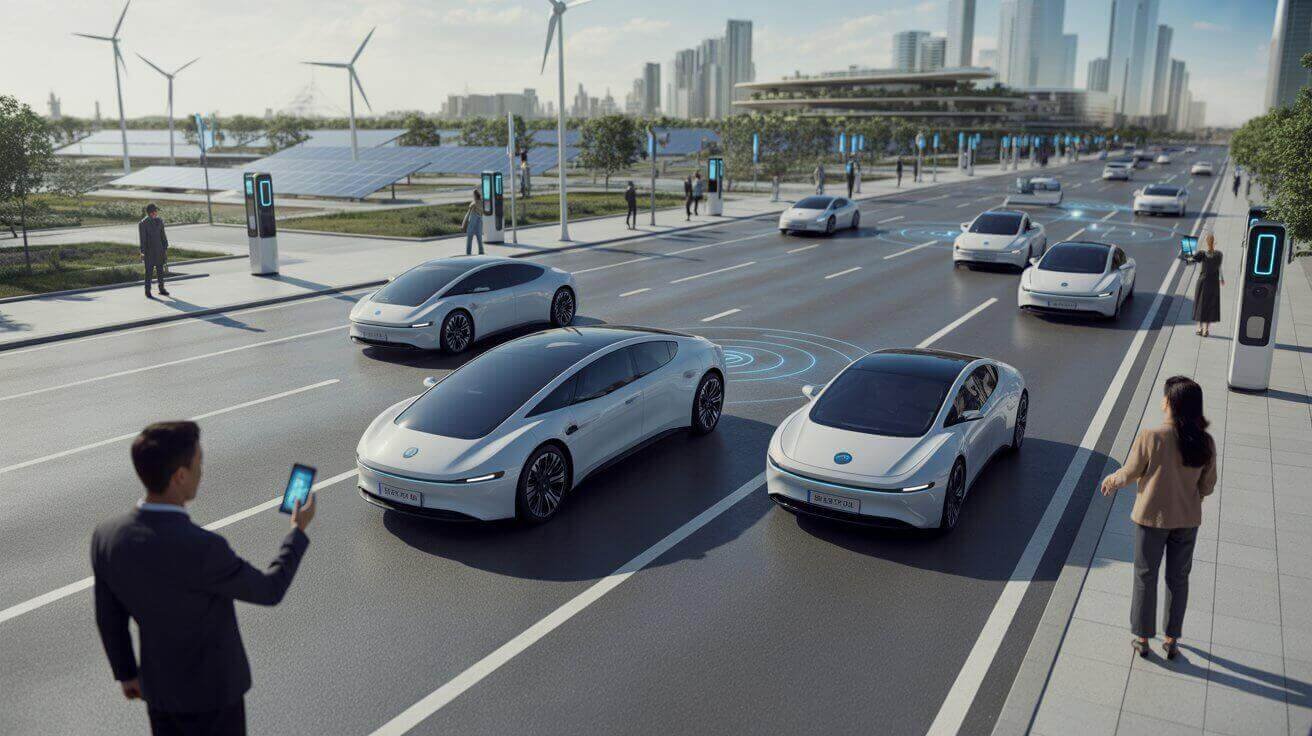Transportation is changing faster than most people realize. We’re witnessing the convergence of two revolutionary technologies that will reshape how we move through our world: electric vehicles and autonomous driving systems. This autonomous electric mobility revolution isn’t just about fancy tech—it’s fundamentally altering our relationship with transportation itself. Moreover, this technology represents the most significant shift in how we think about getting from point A to point B since the invention of the automobile.
The timing couldn’t be more critical. Meanwhile, cities worldwide are grappling with air pollution, traffic congestion, and the urgent need to reduce carbon emissions. Furthermore, traditional transportation infrastructure is reaching its limits just as urban populations continue to grow. Consequently, the integration of electric vehicles and autonomous technology offers a pathway toward cleaner, safer, and more efficient mobility solutions.
The Rise of Advanced Electric and Autonomous Technology
Electric Vehicles Leading the Clean Transportation Revolution
Electric vehicle adoption is accelerating at an unprecedented pace globally. In fact, China dominates the global EV market, with over half of vehicles sold there now electric, while Europe and the United States are rapidly catching up. Additionally, the environmental benefits are becoming increasingly clear as technology improves.
Research consistently shows that electric vehicles typically produce 54% lower lifetime carbon pollution compared to conventional vehicles. Furthermore, this advantage will only grow as electricity generation becomes cleaner. Meanwhile, battery technology continues advancing, with many new models exceeding 400 miles of range on a single charge.
Autonomous Technology Reshaping Mobility Patterns
Self-driving technology is no longer science fiction. Currently, autonomous vehicle companies like Waymo, Zoox, and Chinese firms are already operating robotaxi services in multiple cities. However, the real transformation occurs when autonomous technology combines with electric powertrains.
Autonomous electric mobility systems offer unique advantages that neither technology provides alone. Specifically, electric vehicles are ideal for autonomous fleets because they require less maintenance, operate more quietly, and can be charged efficiently during downtime. Similarly, self-driving technology maximizes electric vehicle efficiency through optimized routing and driving patterns.
The Synergy Between Electric and Autonomous Technologies
The marriage of these technologies creates compelling synergies that enhance both systems. For instance, autonomous vehicles can optimize energy consumption through precise acceleration, braking, and route planning. Additionally, fleet operators can schedule charging during off-peak hours to reduce costs and grid strain.
Moreover, autonomous electric mobility enables new business models impossible with traditional vehicles. Consequently, shared autonomous electric vehicles could dramatically reduce the number of cars needed in cities while providing better service. Therefore, this efficiency gain amplifies the environmental and economic benefits of electrification.
Environmental Benefits Drive Sustainable Transportation Forward
Carbon Emission Reductions Through Smart Mobility Systems
The environmental case for smart electric mobility is compelling and growing stronger. According to comprehensive lifecycle analysis, electric vehicles produce 66-69% lower emissions in Europe and 60-68% lower emissions in the United States compared to gasoline vehicles over their lifetimes.
Furthermore, autonomous technology amplifies these benefits through improved efficiency. Specifically, self-driving vehicles can reduce energy consumption by 10-20% through optimal driving patterns, smoother traffic flow, and reduced congestion. Additionally, shared autonomous fleets could reduce the total number of vehicles needed by up to 90% in urban areas.
Air Quality Improvements in Urban Areas
Beyond carbon emissions, electric and autonomous vehicles deliver immediate air quality benefits for cities. Importantly, electric vehicles produce zero tailpipe emissions, eliminating local air pollutants that harm public health. Meanwhile, autonomous systems can optimize traffic flow to reduce stop-and-go driving, further decreasing overall emissions.
The health benefits are substantial, particularly in dense urban areas. Consequently, reduced air pollution leads to fewer respiratory diseases, cardiovascular problems, and premature deaths. Therefore, the transition to smart mobility systems becomes not just an environmental issue but a public health imperative.
Urban Planning and Infrastructure Transformation
Reimagining City Design for Smart Electric Transportation
Cities are beginning to recognize that modern electric and autonomous vehicles require fundamentally different infrastructure approaches. For example, urban planners must now consider charging infrastructure, smart traffic systems, and dedicated autonomous vehicle lanes in their designs.
Parking infrastructure represents one of the most dramatic changes ahead. Since autonomous vehicles can drop off passengers and park themselves in remote locations, downtown parking lots could be converted to housing, parks, or commercial space. Moreover, shared autonomous fleets would require 90% less parking space than private vehicle ownership.
Smart Charging Infrastructure Development
The success of next-generation transportation depends heavily on intelligent charging infrastructure. Currently, cities are investing in strategic placement of fast-charging stations to support both private electric vehicles and autonomous fleets.
Smart charging systems can coordinate with autonomous vehicles to optimize energy use across the entire transportation network. Additionally, vehicle-to-grid technology allows electric vehicles to store renewable energy and feed it back to the grid during peak demand periods. Therefore, these smart systems become an integral part of clean energy infrastructure.
Practical Implementation Strategies and Real-World Examples
Current Deployments and Pilot Programs
Several cities are already testing smart transportation solutions with promising results. For instance, over 20 Chinese cities are testing fleets of autonomous vehicles, including both private cars and public buses. Similarly, companies like Waymo are expanding their robotaxi services to more U.S. cities.
The key to successful implementation lies in starting small and scaling gradually. Specifically, many transit agencies begin by electrifying buses with fixed routes before expanding to autonomous systems. Meanwhile, ride-sharing companies are integrating electric vehicles into their fleets as stepping stones toward full autonomy.
Overcoming Infrastructure Challenges
The transition to smart electric transportation faces significant infrastructure hurdles that require coordinated solutions. For example, upgrading electrical grids to handle increased charging demand represents a major investment for many communities.
However, smart planning can minimize these challenges. Consequently, cities that implement time-of-use pricing, demand response programs, and distributed charging networks can manage grid impacts more effectively. Furthermore, autonomous vehicles can help by charging during off-peak hours and balancing energy loads across the system.
Economic Considerations and Business Models
The economics of smart electric transportation are becoming increasingly favorable. Although electric vehicles currently cost more upfront, their lower operating costs make them economical over their lifetime. Additionally, autonomous technology promises to reduce labor costs for commercial fleets while improving safety and efficiency.
New business models are emerging around smart transportation that could make mobility more affordable for consumers. For example, mobility-as-a-service platforms could provide door-to-door transportation at lower costs than car ownership. Meanwhile, freight companies are exploring autonomous electric trucks for long-haul routes.
Future Implications: The Road Ahead for Smart Transportation Systems
Technology Advancement Trajectories
The next decade will bring rapid improvements in both electric and autonomous technologies. Battery costs continue falling while energy density increases, making electric vehicles more affordable and practical. Simultaneously, artificial intelligence and sensor technologies are advancing rapidly, bringing full autonomous capability closer to reality.
Autonomous electric mobility will likely reach mainstream adoption in phases. Initially, we’ll see more autonomous features in electric vehicles, followed by fully autonomous vehicles in controlled environments like highway driving. Eventually, urban areas may transition to primarily autonomous electric transportation systems.
Societal and Economic Transformations
The widespread adoption of autonomous electric mobility will trigger profound societal changes beyond transportation itself. For instance, reduced need for parking could free up vast amounts of urban land for housing, recreation, or commercial development. Additionally, transportation costs could decrease significantly, improving mobility access for low-income communities.
The employment implications are substantial but complex. While autonomous vehicles may displace some driving jobs, they’ll create new opportunities in vehicle maintenance, fleet management, and transportation technology. Furthermore, smart mobility systems could provide better transportation access in underserved areas where traditional public transit is inadequate.
Global Policy and Regulatory Evolution
Governments worldwide are developing regulatory frameworks to support smart transportation deployment. Currently, the approach varies significantly between regions, with China pursuing rapid deployment while the U.S. and Europe focus more on safety regulations.
International cooperation on standards and safety protocols will be crucial for widespread adoption of these technologies. Moreover, policymakers must balance innovation encouragement with public safety protection. Therefore, successful regulation will likely involve adaptive frameworks that evolve with technology advancement.
Conclusion: Embracing the Smart Transportation Future
The convergence of electric vehicles and autonomous technology represents more than just technological progress—it’s a fundamental reimagining of how we move through our world. Autonomous electric mobility offers solutions to some of our most pressing challenges: climate change, air pollution, traffic congestion, and transportation equity.
The transition won’t happen overnight, but the momentum is building rapidly. Cities that begin planning now for smart transportation infrastructure will be better positioned to capture its benefits. Meanwhile, individuals and businesses that understand these trends can make informed decisions about their transportation futures.
The environmental benefits alone justify the transition to smart electric and autonomous systems. However, the additional advantages—improved safety, reduced costs, better accessibility, and enhanced quality of life—make this transformation inevitable. The question isn’t whether this future will arrive, but how quickly we can build the infrastructure and policies to support it.
As we stand at this inflection point in transportation history, autonomous electric mobility represents our best opportunity to create cleaner, safer, and more equitable transportation systems. The future of mobility is electric, autonomous, and arriving sooner than most people expect.
Meta Description: “Discover how autonomous electric mobility is transforming transportation with cleaner vehicles, smarter cities, and sustainable solutions for the future.”








